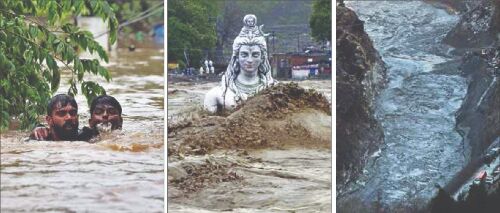Can't COP-out
India’s pledge at COP26 is commendable but real action on the ground will have to follow the Glasgow promise

India's pledge at the COP26 climate summit has largely been well-received. Prime Minister Narendra Modi has optimistically promised to reduce our carbon emissions to net-zero by 2070. The target, though two decades behind many other nations', is still to be applauded given our dependence on coal and fossil fuel. It's also positive that India as the third-largest polluter in the world has at least stepped up with new targets. The frontliners of pollution, the US and China, made no new pledges.
India's pledge at COP26 would have to expedite the actual shift to renewable energy if, as mentioned by the Prime Minister, renewables would help India meet half of its energy requirement by the end of the current decade. Asking developed nations to give USD 1 trillion to developing nations to help reach net-zero targets, was also a relevant demand. After all, the rich nations have had their progress, emerging countries such as India are smack in the middle of theirs.
With uncontrolled carbon emissions increasing global warming, it's been a challenge for the world in general and India in particular, to restrict its carbon footprint. We must contain world temperature rise to 1.5 degree Celsius and no more. Given the gravity of climate change, we would require serious implementation of policies on the ground. And it's not just carbon emissions that should be looked at; unplanned development especially in ecologically sensitive regions must stop. But we don't see that happening. The country's green board has no teeth; the environment ministry makes little noise on climate change. States keep turning a blind eye to the concretisation of locales while effluent-emitting companies ravage the surroundings unabated. Environment experts say that national endeavours such as the building of ports, coastal and mountain highways, and green ticketing of power plants, are also not being thought through. While the rules are there, they are not honestly implemented and as yet, unenforceable. Mangroves are being destroyed and in many parts of the country, development has taken place right on the coast. These environmentally dangerous practices have been allowed and no one is held accountable when disaster strikes.
All this is happening while nature is already playing havoc in our country, coming at the back of mindless deforestation and construction of urban jungles in delicate environs. Look at last month's flooding in Uttarakhand. Over 52 died in the floods that ravaged the region. Climate change and change in land-use are being blamed for the recurrent cloud bursts and rains in the state. As per news reports, 7,750 extreme rainfall and cloud bursts were recorded by the India Meteorology Department (IMD) in the last 6 years; such occurrences have been increasing in the last three years. Even the average rainfall received by the state in October was 485 per cent higher this year.
It's hard to forget the cloud burst of June 2013 that razed parts of Uttarakhand to the ground. I distinctly remember the remnants of the devastation on a reporting trip to the state six months later. As per government records, 5,700 were 'presumed dead'; that was the level of destruction. But that has not been the end of it. Since 2014, over 4,000 people have died in Uttarakhand due to extreme weather that has also resulted in 1,961 landslides, according to a news report. Uttarakhand is not alone, other states such as Assam and Kerala witness regular floods. Rising temperatures, unseasonal rain, and the growing number of cyclones are also warning signs.
Climate change and the destruction caused by it, are very real in India. Even before we reach the net-zero target of 2070, parts of cities such as Kolkata, Mumbai, and Chennai are predicted to be submerged in the next 30 years. Many other cities would be uninhabitable with an increase of 4 degrees of temperature by the end of the century. The truth is that while the net-zero target of 2070 is welcome, we can only conjecture what will happen to us and our next generations in the run-up to India becoming carbon emission-free if rules on the ground are not actually implemented. It will take more than a tossing of coins into Rome's iconic Trevi Fountain to bring 'good luck' in our fight against the climate crisis.
The writer is an author and media entrepreneur. Views expressed are personal



